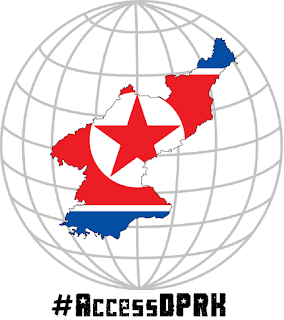One year ago today I published Phase I of my #AccessDPRK Mapping Project. I began mapping North Korea in late 2012, little did I know how much of an effort it would take or how expansive a map would result from the over 2,500 hours of work. I won't recount why I started, you can read more about that here, but I do want to stress that this map has become the largest and most comprehensive map of North Korea publicly available, by far.
The Google Earth file contains 53,722 placemarks covering three main areas of interest: the military, monuments, and domestic/economic sites. There are 9,567 military sites, 8,859 monument markers representing 9,879 individual monuments, and 35,296 domestic sites. Because I started mapping after I discovered Curtis Melvin's map and because I updated and incorporated his North Korea Uncovered into mine, I would like to say that of the 53,722 places, 8,430 of them came from North Korea Uncovered.
The file is divided according to each province and each province is divided into those three main areas (some have an extra division). Those three divisions are further sub-divided into item-specific folders (anti-aircraft artillery, dams, palaces, etc.). Typically, the military division has around 20 folders and the domestic division has around 40. The monument division is just a single folder containing all of the monuments in its respective province. There is also an "Additional Items" folder that has things like all the country's airports and a list of mountains. And, there is a file dedicated to the De-Militarized Zone with 1,401 places marked.
Because of the size of the KMZ file (4.76 MB - which is huge by Google Earth terms), don't try to view the whole thing at once. Expand the file and pick out which province you'd like to review and then what item folders you want. There are many ways to explore the information within, just take a little time to get used to the layout so you don't accidentally crash Google Earth (although, most modern computers can handle having the entire file open, it may be sluggish).
The next part of #AccessDPRK is to create a series of topic-specific files. For example, the country's electrical grid. This will allow those with narrower interests to view the information they want without the need to dig through mountains of data. However, there is no firm time set for me to build and publish those maps. After working on this for so long, I'm in the mood to take things more slowly now.
Map showing every monument in North Korea. Click for larger view (opens in new window).
[Note: the download link to the 2017 map has been removed as the 2021 version was made available.]
Below is a breakdown of the number of items per province and other main folders. As soon as I can I will also add some graphics showing how many of each item there are (like the fact there's active 1,539 anti-aircraft artillery batteries).
Phase II Complete Item Counts - March 5, 2017
Chagang Province = 2,695
Military: 162
Monument: 544 markers rep. 585 monuments
Domestic: 1,989
Kangwon Province = 4,443
Military: 1,131
Monument: 762 markers rep. 928 monuments
Domestic: 2,550
N. Hamgyong Province = 4,690
Military: 450
Monument: 765 markers rep. 796 monuments
Domestic: 3,475
S. Hamgyong Province = 6,300
Military: 627
Monument: 1,053 markers rep. 1,154 monuments
Domestic: 4,620
N. Hwanghae Province = 5,833
Military: 1,347
Monument: 946 markers rep. 1,100 monuments
Domestic: 3,540
S. Hwanghae Province = 6,304
Military: 1,008
Monument: 1,054 markers rep. 1,146 monuments
Domestic: 4,242
N. Pyongan Province = 5,581
Military: 716
Monument: 1,049 markers rep. 1,145 monuments
Domestic: 3,816
S. Pyongan Province = 7,002
Military: 1,134
Monument: 1,205 markers rep. 1,325 monuments
Domestic: 4,663
Pyongyang District = 6,150
Military: 1,129
Monument: 1,049 markers rep. 1,230 monuments
Water supply: 290
Domestic: 3,682
Rason District = 531
Military: 42
Monument: 94 markers rep. 99 monuments
Domestic: 395
Ryanggang Province = 2,183 total
Military: 95
Monument: 338 markers rep. 371 monuments
Domestic: 1,626
Mt. Paektu: 126 - inc. 2 duplicates not inc. in counts elsewhere
DMZ-area Road Blocks: 198
DMZ: 1,401 + 394 miles of fence
Tall Mountains: 245
Airports: 127 (108 runways and 19 waypoints)
UN Joint Security Area: 5
Border Crossings: 24
Large intersections: 10
**********Grand Totals**********
Grand Total: 53,722 markers
Military: 8,201 + DMZ/RBs/Airports = 9,567
Monuments: 8,859 markers representing 9,879 monuments
Domestic (inc. Border/Intersections/Mts) = 35,296
NOTE: AccessDPRK maps, articles, or other creations may not be used for commercial purposes without the express authorization of Jacob Bogle.
--Jacob Bogle, 3/5/17
www.JacobBogle.com
Facebook.com/JacobBogle
Twitter.com/JacobBogle




